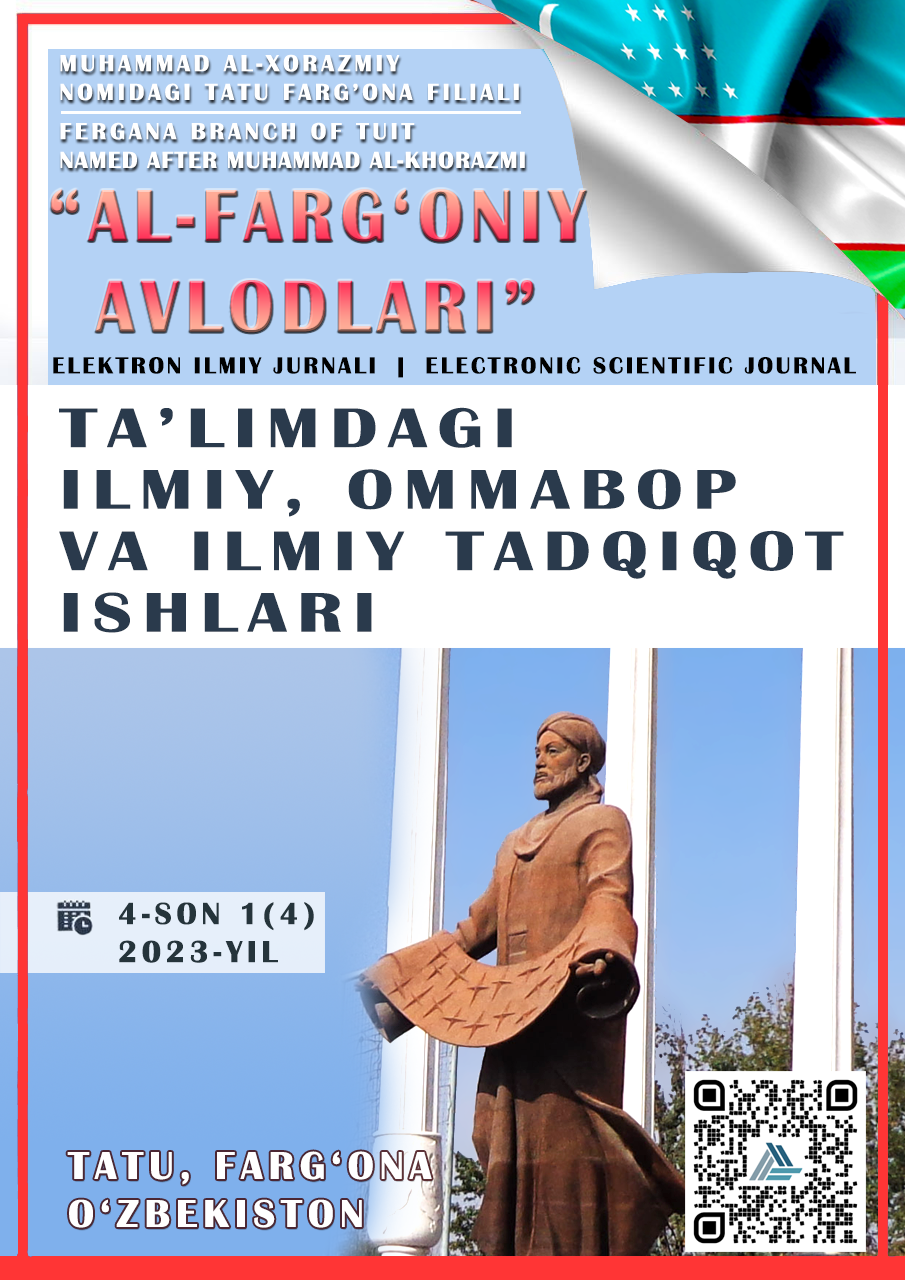USE OF ARTIFICIAL INTELLIGENCE TOOLS IN EDUCATION CONTROL AND ASSESSMENT
Keywords:
Sun’iy intellekt, IRT, TTQI, video konferensiya vositalari, kengaytirilgan reallik, virtual reallik.Abstract
Artificial Intelligence (AI) is transforming many industries and education is no exception. Rapid advances in AI technology have become necessary for educators and educational assessment professionals to improve the teaching and learning experience. AI-based educational assessment tools provide many benefits, including increasing the accuracy and effectiveness of assessments, creating personalized feedback for students, and allowing teachers to tailor their instructional strategies to meet the unique needs of each student. Therefore, AI has the potential to revolutionize the way education is delivered and assessed, resulting in better learning outcomes for students. This research paper explores the various uses of AI tools in educational measurement and evaluation.
References
Halaweh, M. (2023). ChatGPT in education: Strategies for responsible implementation. Contemporary Educational Technology, 15(2), ep421. https://doi.org/10.30935/cedtech/13036
Mena-Guacas, A. F., Urueña Rodríguez, J. A., Santana Trujillo, D. M., Gómez-Galán, J., & López-Meneses, E. (2023). Collaborative learning and skill development for educational growth of artificial intelligence: A systematic review. Contemporary Educational Technology, 15(3), ep428. https://doi.org/10.30935/cedtech/13123
Papapicco, C. (2020). Google mini: Italian example of artificial pro-sociality. Online Journal of Communication and Media Technologies, 10(3), e202015. https://doi.org/10.29333/ojcmt/7995
Adiguzel, T., Kaya, M. H., & Cansu, F. K. (2023). Revolutionizing education with AI: Exploring the transformative potential of ChatGPT. Contemporary Educational Technology, 15(3), ep429. https://doi.org/10.30935/cedtech/13152
Lin, P. Y., Chai, C. S., Jong, M. S. Y., Dai, Y., Guo, Y., & Qin, J. (2021). Modelling the structural relationship among primary students’ motivation to learn artificial intelligence. Computers and Education: Artificial Intelligence, 2, 100006. https://doi.org/ 10.1016/j.caeai.2020.100006
Xia, Q., Chiu, T. K. F, Lee, M., Temitayo I., Dai, Y., & Chai, C. S. (2022). A self-determination theory design approach for inclusive and diverse artificial intelligence (AI) K-12 education. Computers & Education, 189, 104582. https://doi.org/10.1016/j. compedu.2022.104582
Huang, A. Y., Lu, O. H., & Yang, S. J. (2023a). Effects of artificial intelligence-enabled personalized recommendations on learners’ learning engagement, motivation, and outcomes in a flipped classroom. Computers & Education, 194, 104684. https://doi.org/10.1016/j.compedu.2022.104684
Nazari, N., Shabbir, M. S., & Setiawan, R. (2021). Application of artificial intelligence powered digital writing assistant in higher education: Randomized controlled trial. Heliyon, 7(5), e07014. https://doi.org/10.1016/j.heliyon.2021.e07014
Hou, J., Li, Z., & Liu, G. (2022). Macro education approach to improve learning interest under the background of artificial intelligence. Wireless Communications and Mobile Computing, 2022, 4295887. https://doi.org/10.1155/2022/4295887
Karsenti, T. (2019). Artificial intelligence in education: The urgent need to prepare teachers fortomorrow’s schools. Formation et Profession [Education and Profession], 27(1), 112-116. https://doi.org/10. 18162/fp.2019.a166
Hawes, D., & Arya, A. (2023). Technology solutions to reduce anxiety and increase cognitive availability in students. IEEE Transactions on Learning Technologies, 16(2), 278-291. https://doi.org/10. 1109/TLT.2023.3239985
Kumar, N. S. (2019). Implementation of artificial intelligence in imparting education and evaluating student performance. Journal of Artificial Intelligence, 1(01), 1-9. https://doi.org/10.36548/jaicn.2019.1. 001
Luo, Y., Han, X., & Zhang, C. (2022). Prediction of learning outcomes with a machine learning algorithm based on online learning behavior data in blended courses. Asia Pacific Education Review. https://doi.org/10.1007/s12564-022-09749-6
Khan, I., Ahmad, A. R., Jabeur, N., & Mahdi, M. N. (2021). An artificial intelligence approach to monitor student performance and devise preventive measures. Smart Learning Environments, 8(1), 1-18. https://doi.org/10.1186/s40561-021- 00161-y
Owan, V. J., Abang, K. B., Idika, D. O., Etta, E. O., & Bassey, B. A. (2023). Exploring the potential of artificial intelligence tools in educational measurement and assessment. Eurasia Journal of Mathematics, Science and Technology Education, 19(8), em2307. https://doi.org/10.29333/ejmste/13428
O.Babomuradov, B Otaxonova, NS Mamatov, LB Boboev. Text documents classification in Uzbek language. International journal of recent technology and engineering 8 (2S11), 3787-3789
N. A. Niyozmatova, N. S. Mamatov, B. I. Otaxonova, A. N. Samijonov and K. K. Erejepov, "Classification Based On Decision Trees and Neural Networks," 2021 International Conference on Information Science and Communications Technologies (ICISCT), Tashkent, Uzbekistan, 2021, pp. 01-04, doi: 10.1109/ICISCT52966.2021.9670345
Mamatov, N. S., Niyozmatova, N. A., Jalelova, M. M., Samijonov, A. N., & Tojiboyeva, S. X. (2023). Methods for improving contrast of agricultural images. In E3S Web of Conferences (Vol. 401, p. 04020). EDP Sciences.
Mamatov, N., Pulatov, G., & Jalelova, M. (2023). Тасвир контрастини ошириш усули ва контраст баҳолаш мезон оптимал жуфтлиги. Digital transformation and artificial intelligence, 1(2), 158–167. Retrieved from https://dtai.tsue.uz/index.php/dtai/article/view/v1i225
Wiedecke, Bernd & Mamatov, Narzillo & Payazov, Mirabbos & Samijonov, Abdurashid. (2019). Acoustic Signal Analysis and Identification. International Journal of Innovative Technology and Exploring Engineering. 8. 2440-2442. 10.35940/ijitee. J9522.0881019.
Mamatov, N., Niyozmatova, N., Samijonov, A. 2021. Software for preprocessing voice signals. International Journal of Applied Science and Engineering, 18, 2020163. https://doi.org/10.6703/IJASE.202103_18(1).006
Narzillo, M., Abdurashid, S., Parakhat, N., & Nilufar, N. (2019). Automatic speaker identification by voice based on vector quantization method. International Journal of Innovative Technology and Exploring Engineering, 8(10), 2443–2445. https://doi.org/10.35940/ijitee.J9523.0881019
Mamatov, Narzillo & Samijonov, Abdurashid & Nilufar, Niyozmatova. (2019). Karakalpak Speech Recognition with CMU Sphinx. International Journal of Innovative Technology and Exploring Engineering. 8. 2446-2448. 10.35940/ijitee. J9524.0881019.
Mamatov, Narzillo & Niyozmatova, N. & Abdullaev, Sh & Samijonov, Abdurashid & Erejepov, K. (2021). Speech Recognition Based On Transformer Neural Networks. 1-5. 10.1109/ICISCT52966.2021.9670093.
Mamatov, N., Dusanov, X., & Pulatov, G. (2023). SHAXSNI OVOZI ASOSIDA TANIB OLISH USULLARI. DIGITAL TRANSFORMATION AND ARTIFICIAL INTELLIGENCE, 1(2), 90–95. Retrieved from https://dtai.tsue.uz/index.php/dtai/article/view/v1i218
Bassey, B. A., Ubi, I. O., Anagbogu, G. E., & Owan, V. J. (2020). Permutation of UTME multiple-choice test items on performance in use of English and mathematics among prospective higher education students. The Journal of Social Sciences Research, 6(4), 483-493. https://doi.org/10.32861/jssr.64.483.493
S. Ibrokhimov, K. L. Hui, A. Abdulhakim Al-Absi, h. j. lee and M. Sain, "Multi-Factor Authentication in Cyber Physical System: A State of Art Survey," 2019 21st International Conference on Advanced Communication Technology (ICACT), PyeongChang, Korea (South), 2019, pp. 279-284, doi: 10.23919/ICACT.2019.8701960.
Additional Files
Published
How to Cite
License
Copyright (c) 2023 Нарзилло Маматов, Санжар Иброхимов, Вохид Маматов, Абдурашид Самижонов

This work is licensed under a Creative Commons Attribution-NonCommercial-NoDerivatives 4.0 International License.












